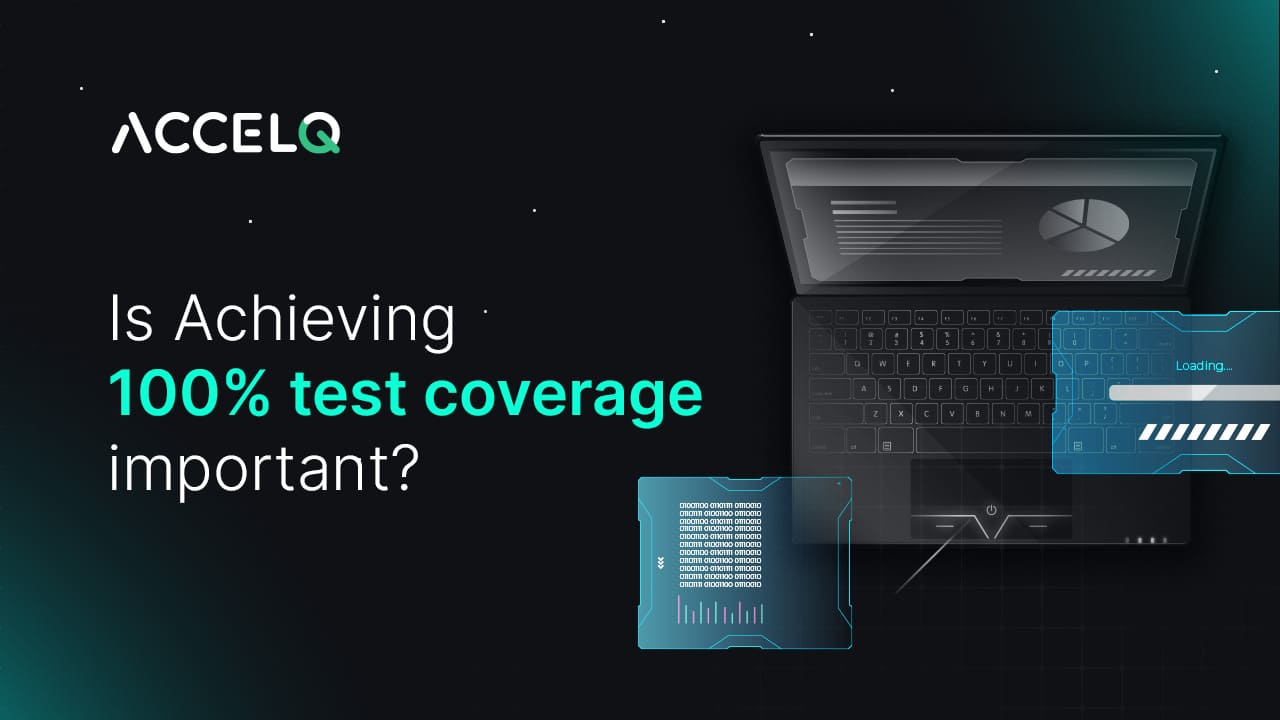Is Achieving 100% Test Coverage Important?

In a 2022 report, the Consortium for Information and Software Quality (CISQ) reported that the cost of poor-quality software had grown to $2.41 trillion. Indeed, testing the code base is non-negotiable in a software-driven world. Expanding the testing footprint and test coverage is now a priority for anyone developing software. But what is test coverage, and is achieving 100% test coverage important?
What Exactly Does 100% Test Coverage Mean?

Test coverage measures how much of the codebase has been tested. It aims to cover maximum application code, modules, functionalities, and requirements using test cases. Usually assigned to unit and integration tests, test coverage measures how much of the code in the application has been executed when these tests are conducted.
However, it is important to note that achieving 100% test coverage might not be possible in the literal sense. Instead, testing teams should aim at achieving maximum test coverage and ensure that there are sufficient tests to cover the maximum of code in the application. By structuring these tests correctly, it becomes theoretically possible to predict what some input would do to get some output.
Maximum test coverage can prove vital as it gives developers more confidence in their code and the quality of the application.
Benefits of Achieving Maximum Test Coverage

100% test coverage becomes a great idea when it covers specific use cases. However, it's important to write code more purposefully and verify scenarios and not just write tests that execute code in the background.
To that end, some of the clear benefits of achieving maximum coverage e are:
Better Identification of Test Case Gaps & Broken Code
Identifying and fixing broken code and gaps in test cases becomes easier when teams try to aim for maximum % test coverage. This approach allows teams to become more exploratory and discover code that has been failing silently and could have previously gone unnoticed.
It becomes easier to identify when to write additional tests to cover a scenario that is not delivering the desired test results. Maximizing test coverage helps testing teams discover test case gaps that impact the overall efficiency of the tests and can lead to broken tests. It enables teams to identify that the application has not been tested completely, even if it may look like that due to a high number of test cases.
Prevention of Defect Leakage
Test coverage also helps teams identify the defect leakage. Defect leakage measures the percentage of problems that leak from one testing stage to the next. Measuring this allows teams to determine the efficacy of testing initiatives.
Gunning for 100% test coverage helps prevent defect leakage as well. By ensuring more test coverage, the defect leakage percentage reduces considerably as teams can identify issues such as bad coding techniques like unhandled failures, missed deviations, incorrect input validations, etc. This helps teams prevent bugs from moving from one testing stage to another.
Elimination of Redundancy
Looking at achieving maximum test coverage allows testing teams to control and eliminate redundancy. Defining test coverage and then trying to achieve 100% of it can help teams uncover misleading scenarios. It allows testing teams to highlight the need for new test cases that could execute newer lines, reduce bugs, and save time and costs by identifying and eliminating redundancies.
Download the 100% Free Guide
Master the essentials of advanced approach
to object recognition.

Why Is the Pursuit of 100% Test Coverage Not Always Right?
While it might seem that achieving 100% test coverage is the magic pill to create perfect software, going for 100% test coverage for the sake of it can lead to disappointing outcomes.
Some of the reasons why the pursuit of 100% test coverage isn't ideal are:
Too Much Time and Resource Consumption
Writing test cases to achieve 100% coverage isn't a small feat. While employing automation is essential, the question surfaces — who will test the test automation code? Testers not only have to write automated tests but also have to test the test automation code for confidence in test results.
It is also important to remember that 100% coverage means that 100% of the lines of code have been executed while running the tests. If some code is executed and no tests are in place to verify what is being executed, then the testers are effectively tricking themselves. Testers also spend time creating a bundle of test cases that might be of little value.
So, to move towards 100% coverage, testing teams have to verify that every single method returns exactly as per the requirement. Only then does 100% test coverage have any value. However, this can become a very time-consuming and resource-intensive activity.
No Guarantee That Everything Works as Intended
100% test coverage does not essentially mean that everything is working as it should. Testing teams might write tests for a controller, for example. But what if the test functions for the controller, but the middleware prevents the user from reaching it? The test, in this case, comes green, but despite that, the application doesn't work as intended.
Quality Above Quantity All Day
Solely relying on the percentage of test coverage can provide a false sense of security. Just because all the code runs properly does not mean it will give accurate results. While 100% coverage acts as a safety net, it is essential to ensure quality over quantity. Testing teams should verify whether a single method returns precisely what is intended and that the application works as it should.
When it comes to 100% coverage, teams need to ensure that there is more focus on the code that actually has to be tested than focusing only on covering 100% of the code lines.
Conclusion
Achieving maximum test coverage is good, provided testing teams know what to test. Gunning for 100% test coverage only for the sake of it has no benefit. It's only a waste of time, resources, and money.
However, if teams look at 100% test coverage as a goal that helps them structure code better, write simple code, and eliminate unused scripts, then it delivers excellent value. It is also essential to arm testers with AI-powered no-code test automation platforms. They can then create and maintain reliable tests with greater agility and little effort.
Connect with us to see how ACCELQ's no-code test automation platform can help you achieve true maximum test coverage.
Balbodh Jha
Associate Director Product Engineering
Balbodh is a passionate enthusiast of Test Automation, constantly seeking opportunities to tackle real-world challenges in this field. He possesses an insatiable curiosity for engaging in discussions on testing-related topics and crafting solutions to address them. He has a wealth of experience in establishing Test Centers of Excellence (TCoE) for a diverse range of clients he has collaborated with.
Discover More
 How Agentic Automation Is Transforming Modern QA Workflows?
How Agentic Automation Is Transforming Modern QA Workflows?
How Agentic Automation Is Transforming Modern QA Workflows?
 Parallel Testing in Software Testing | Comprehensive Guide 2025
Parallel Testing in Software Testing | Comprehensive Guide 2025

































